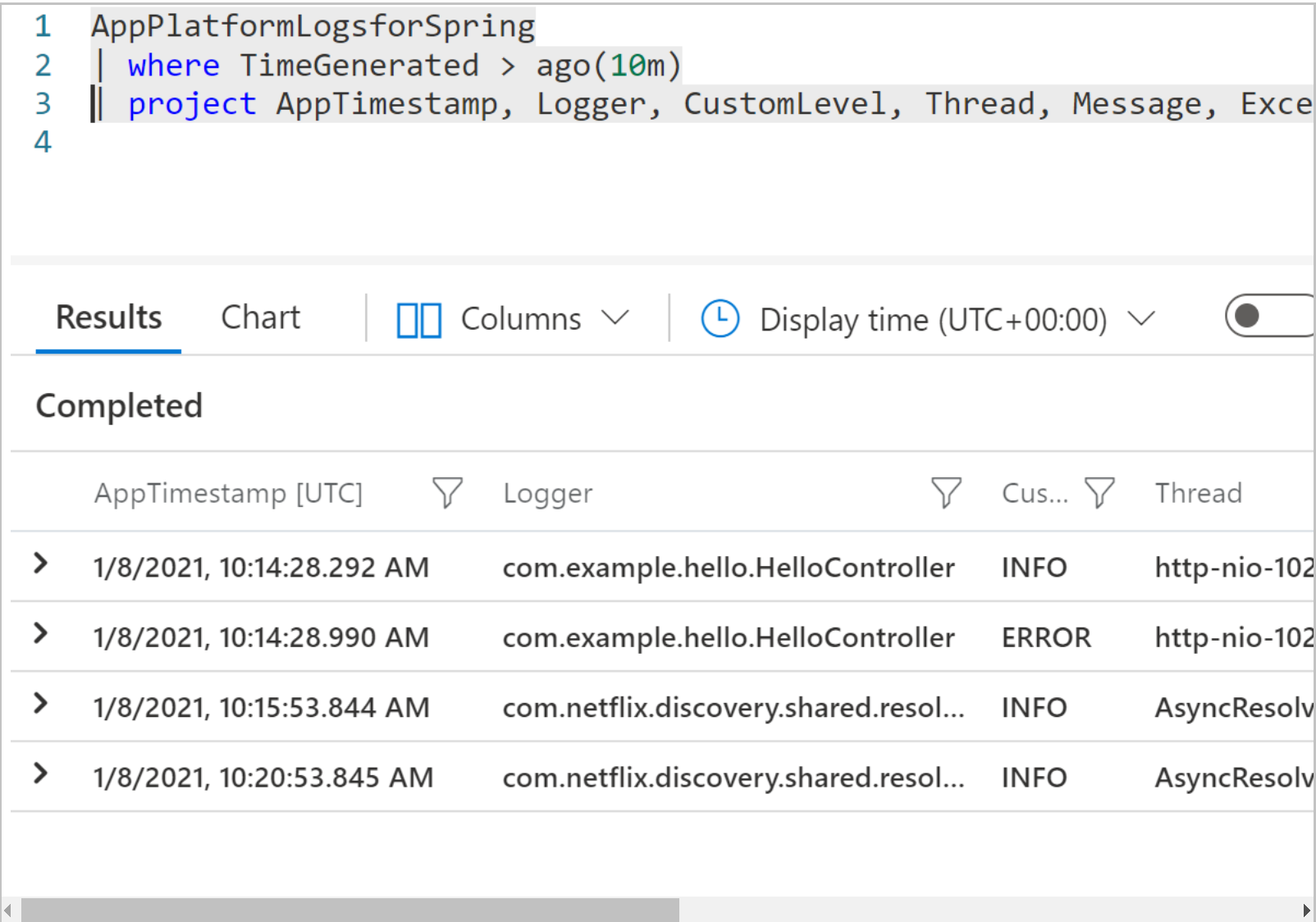注意
基本标准计划于 2025 年 3 月 17 日进入退休期。 有关详细信息,请参阅 Azure Spring Apps 停用公告。
标准消耗和专用计划于 2024 年 9 月 30 日进入停用期,并将在 2025 年 3 月底之前完全关闭。
本文介绍了如何在 Azure Spring Apps 中生成和收集结构化应用程序日志数据。 Azure Spring Apps 使用正确的配置通过 Log Analytics 提供有用的应用程序日志查询和分析。
日志架构要求
若要改进日志查询体验,应用程序日志必须采用 JSON 格式,并遵循某个架构。 Azure Spring Apps 使用此架构分析你的应用程序并流式传输到 Log Analytics。
注意
启用 JSON 日志格式会导致难以从控制台读取日志流式处理输出。 若要获取人类可读的输出,请将 --format-json 参数追加到 az spring app logs CLI 命令。 请参阅设置 JSON 结构化日志的格式。
JSON 架构要求:
| JSON 密钥 | JSON 值类型 | 必需 | Log Analytics 中的列 | 说明 |
|---|---|---|---|---|
| 时间戳 | 字符串 | 是 | 应用时间戳 | UTC 格式的时间戳 |
| 记录器 | 字符串 | 否 | 记录器 | 记录器 |
| 级别 | 字符串 | 否 | 自定义等级 | 日志级别 |
| 线程 (thread) | 字符串 | 否 | 线程 | 线程 (thread) |
| 消息 | 字符串 | 否 | 消息 | 日志消息 |
| stackTrace | 字符串 | 否 | StackTrace | 异常堆栈跟踪 |
| 例外类 (exceptionClass) | 字符串 | 否 | 异常类(ExceptionClass) | 异常类名称 |
| mdc | 嵌套的 JSON | 否 | 映射的诊断上下文 | |
| mdc.traceId | 字符串 | 否 | TraceId | 分布式跟踪的跟踪 ID |
| mdc.spanId | 字符串 | 否 | SpanId | 分布式跟踪的范围 ID |
- “timestamp”字段是必需的,并且应当采用 UTC 格式,所有其他字段都是可选的。
- “mdc”字段中的“traceId”和“spanId”用于跟踪。
- 在单个行中记录每条 JSON 记录。
日志记录示例
{"timestamp":"2021-01-08T09:23:51.280Z","logger":"com.example.demo.HelloController","level":"ERROR","thread":"http-nio-1456-exec-4","mdc":{"traceId":"c84f8a897041f634","spanId":"c84f8a897041f634"},"stackTrace":"java.lang.RuntimeException: get an exception\r\n\tat com.example.demo.HelloController.throwEx(HelloController.java:54)\r\n\","message":"Got an exception","exceptionClass":"RuntimeException"}
限制
JSON 日志的每行最多包含 16 K 字节。 如果单个日志记录的 JSON 输出超过此限制,它将分成多行,并将每个原始行收集到 Log 列中,而不会在结构上进行分析。
通常,这种情况发生在使用深度 stacktrace 的异常日志记录上(特别是在已启用 AppInsights 进程内代理时)。 将限制设置应用到 stacktrace 输出(请参阅下面的配置示例)以确保正确分析最终输出。
生成遵循架构的 JSON 日志
对于 Spring 应用程序,可以使用常用的记录框架(例如 logback 和 log4j2)生成预期的 JSON 日志格式。
使用 logback 进行记录
使用 Spring Boot 入门版时,默认情况下将使用 Logback。 对于 Logback 应用,请使用 logstash-encoder 生成 JSON 格式的日志。 Spring Boot 版本 2.1 及更高版本支持此方法。
此过程:
在 pom.xml 文件中添加 logstash 依赖项。
<dependency> <groupId>net.logstash.logback</groupId> <artifactId>logstash-logback-encoder</artifactId> <version>6.5</version> </dependency>更新
logback-spring.xml配置文件以设置 JSON 格式。<configuration> <appender name="stdout" class="ch.qos.logback.core.ConsoleAppender"> <encoder class="net.logstash.logback.encoder.LoggingEventCompositeJsonEncoder"> <providers> <timestamp> <fieldName>timestamp</fieldName> <timeZone>UTC</timeZone> </timestamp> <loggerName> <fieldName>logger</fieldName> </loggerName> <logLevel> <fieldName>level</fieldName> </logLevel> <threadName> <fieldName>thread</fieldName> </threadName> <nestedField> <fieldName>mdc</fieldName> <providers> <mdc /> </providers> </nestedField> <stackTrace> <fieldName>stackTrace</fieldName> <!-- maxLength - limit the length of the stack trace --> <throwableConverter class="net.logstash.logback.stacktrace.ShortenedThrowableConverter"> <maxDepthPerThrowable>200</maxDepthPerThrowable> <maxLength>14000</maxLength> <rootCauseFirst>true</rootCauseFirst> </throwableConverter> </stackTrace> <message /> <throwableClassName> <fieldName>exceptionClass</fieldName> </throwableClassName> </providers> </encoder> </appender> <root level="info"> <appender-ref ref="stdout" /> </root> </configuration>使用带
-spring后缀(如logback-spring.xml)的日志记录配置文件时,可基于 Spring 活动配置文件设置日志记录配置。<configuration> <springProfile name="dev"> <!-- JSON appender definitions for local development, in human readable format --> <include resource="org/springframework/boot/logging/logback/defaults.xml" /> <include resource="org/springframework/boot/logging/logback/console-appender.xml" /> <root level="info"> <appender-ref ref="CONSOLE" /> </root> </springProfile> <springProfile name="!dev"> <!-- JSON appender configuration from previous step, used for staging / production --> ... </springProfile> </configuration>对于本地开发,请使用 JVM 参数
-Dspring.profiles.active=dev运行 Spring 应用程序,然后可看到人工可读的日志,而不是 JSON 格式的行。
使用 log4j2 进行记录
对于 log4j2 应用,请使用 json-template-layout 生成 JSON 格式的日志。 Spring Boot 2.1+ 版支持此方法。
此过程:
在 pom.xml 文件中排除
spring-boot-starter-loggingspring-boot-starter、添加依赖项spring-boot-starter-log4j2log4j-layout-template-json。<dependency> <groupId>org.springframework.boot</groupId> <artifactId>spring-boot-starter-web</artifactId> <exclusions> <exclusion> <groupId>org.springframework.boot</groupId> <artifactId>spring-boot-starter-logging</artifactId> </exclusion> </exclusions> </dependency> <dependency> <groupId>org.springframework.boot</groupId> <artifactId>spring-boot-starter-log4j2</artifactId> </dependency> <dependency> <groupId>org.apache.logging.log4j</groupId> <artifactId>log4j-layout-template-json</artifactId> <version>2.14.0</version> </dependency>在类路径中准备一个 JSON 布局模板文件
jsonTemplate.json。{ "mdc": { "$resolver": "mdc" }, "exceptionClass": { "$resolver": "exception", "field": "className" }, "stackTrace": { "$resolver": "exception", "field": "stackTrace", "stringified": true }, "message": { "$resolver": "message", "stringified": true }, "thread": { "$resolver": "thread", "field": "name" }, "timestamp": { "$resolver": "timestamp", "pattern": { "format": "yyyy-MM-dd'T'HH:mm:ss.SSS'Z'", "timeZone": "UTC" } }, "level": { "$resolver": "level", "field": "name" }, "logger": { "$resolver": "logger", "field": "name" } }在
log4j2-spring.xml配置文件中使用此 JSON 布局模板。<configuration> <appenders> <console name="Console" target="SYSTEM_OUT"> <!-- maxStringLength - limit the length of the stack trace --> <JsonTemplateLayout eventTemplateUri="classpath:jsonTemplate.json" maxStringLength="14000" /> </console> </appenders> <loggers> <root level="info"> <appender-ref ref="Console" /> </root> </loggers> </configuration>
在 Log Analytics 中分析日志
正确设置应用程序后,应用程序控制台日志会流式传输到 Log Analytics。 此结构可在 Log Analytics 中实现高效查询。
在 Log Analytics 中查看日志结构
请按以下过程操作:
转到你的服务实例的服务概述页。
选择“监视”部分中的“日志”条目 。
运行此查询。
AppPlatformLogsforSpring | where TimeGenerated > ago(1h) | project AppTimestamp, Logger, CustomLevel, Thread, Message, ExceptionClass, StackTrace, TraceId, SpanId将返回应用程序日志,如下图所示:
显示包含错误的日志条目
若要查看包含错误的日志条目,请运行以下查询:
AppPlatformLogsforSpring
| where TimeGenerated > ago(1h) and CustomLevel == "ERROR"
| project AppTimestamp, Logger, ExceptionClass, StackTrace, Message, AppName
| sort by AppTimestamp
使用此查询查找错误,或修改查询词以查找特定的异常类或错误代码。
显示特定 traceId 的日志条目
若要查看特定跟踪 ID“trace_id”的日志条目,请运行以下查询:
AppPlatformLogsforSpring
| where TimeGenerated > ago(1h)
| where TraceId == "trace_id"
| project AppTimestamp, Logger, TraceId, SpanId, StackTrace, Message, AppName
| sort by AppTimestamp
后续步骤
- 若要详细了解日志查询,请参阅 Azure Monitor 中的日志查询入门。
